Are you a Quiet Speculation member?
If not, now is a perfect time to join up! Our powerful tools, breaking-news analysis, and exclusive Discord channel will make sure you stay up to date and ahead of the curve.
Most of my articles are related to the financial aspects of Magic, and this one won't stray too far, at least in spirit. Building Storm is an inexpensive way for a player to get into Modern without giving up much on the competitive front. I honestly believe this deck is a great option right now. I have been playing it to some success and feel confident enough to present it to you as a viable budget-friendly deck. Let's talk about the basics–where the deck is strong, where it lacks, and what kind of sideboarding you can do for common opponents. After all that, I'll offer some passing thoughts on a few Amonkhet spoilers.
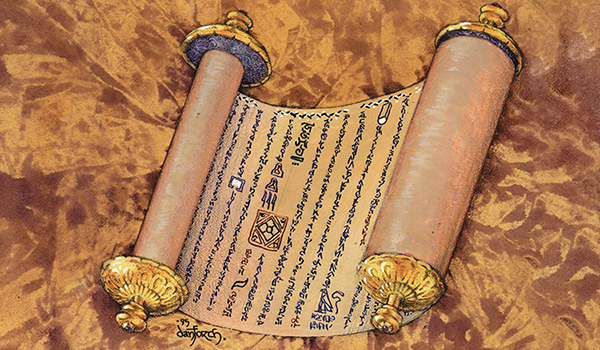
The Gifts Storm deck has many different variations, but for the most part builds share the same core. There are 5-8 flex slots in the maindeck, and the sideboards are really all over the place. I am playing the simplest and most straightforward version (in my opinion), until I get a better feel for what I want to change.
Gifts Storm, by Jim Casale
This maindeck is a nice medium that maxes out on the most relevant combo pieces and removes a lot of the decision-making processes that could cause a newer pilot to lose. The Merchant Scroll was pretty bad in hindsight and I'd probably just play another Thought Scour instead.
One major difference in this list compared to others is the substitution of Scalding Tarn with Flooded Strand. Although it was a pretty small sample size, I'll admit that I never wanted to fetch the basic Mountain in the 20ish matches I've played with this deck. Due to the fact that the deck is pretty land-light to begin with, you frequently find yourself keeping land-light hands that necessitate fetching Steam Vents even against aggressive decks like Burn. If you're going to eschew the Scalding Tarns completely I would probably suggest putting another Shivan Reef into the deck over a basic Mountain. I have drawn the Mountain in my opening hand several times and been forced to mulligan because it doesn't produce blue mana.
The sideboard is also pretty stock. It leverages your ability to Blood Moon some decks out of the game (as early as turn two with a ritual). It also has some of the best answers to the most relevant hate cards. I'll discuss later exactly when I bring in each card, but this is definitely the most broad-reaching sideboard strategy.
Strengths and Weaknesses
Storm is at its best against non-interactive opponents. In a pure race, when both you and your opponent are left to your own devices to execute your gameplans, Storm is consistently the faster deck. That means you're likely favored in a room with lots of other combo decks. Good matchups include Tron, Ad Nauseam, Primeval Titan decks (both Amulet and Valakut), Dredge, Merfolk, and Elves. Matchups that go 50/50 are the linear aggro decks (Burn, Infect, Affinity, Zoo), which present light disruption and a clock just slightly slower than yours.
The deck struggles against strategies with a heavy amount of discard or counterspells, removal, and a clock. These decks include Death's Shadow, Jund, Abzan, Grixis Delver, and basically any deck that plays Inquisition of Kozilek/Thoughtseize, Lightning Bolt/Path to Exile, and Tarmogoyf. Storm is fairly redundant and can function off of relatively few resources. But it can also be picked apart, and it requires more cogs to win the game than most A + B combo decks. The deck is also susceptible to graveyard hate. If your local play group has a lot of people that play Rest in Peace, Ravenous Trap, or Surgical Extraction, I would consider playing something else.
Tips and Tricks
For as far back as I can remember, Storm has been one of the more complicated decks in any format it appears in. That said, the current Modern version should be easy for first-time Storm pilots to pick up. The basic gist of the deck is to stick a mana-reduction creature (Baral, Chief of Compliance or Goblin Electromancer), cast a bunch of rituals, resolve Gifts Ungiven, and then win the game. The most complicated part is figuring out what to Gifts for, and whether to sneak in extra mana-reducers to up the storm count. If you draw a Past in Flames, things change a little.
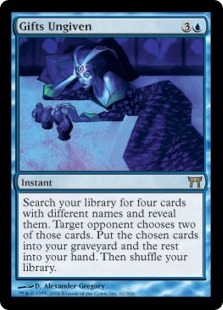 When you cast Gifts, you need to have at least 3 mana floating in order not to fizzle with one mana reducer. If you're sure it won't get countered or killed (i.e. your opponent is tapped out), you can sneak in an extra mana reducer first. Just make sure that you still have 2 mana left over, including 1 red.
When you cast Gifts, you need to have at least 3 mana floating in order not to fizzle with one mana reducer. If you're sure it won't get countered or killed (i.e. your opponent is tapped out), you can sneak in an extra mana reducer first. Just make sure that you still have 2 mana left over, including 1 red.
The first pile I go for in this case is usually a mana pile of Pyretic Ritual, Desperate Ritual, Manamorphose, and Past in Flames. If you have less than 3 mana floating, your opponent can give you Past in Flames and the Manamorphose and you can fizzle. Past in Flames costs 3 mana with a reduction and Manamorphose nets 1 mana with a reduction, so that leaves you with 4 mana after you cast it. When you cast Past in Flames, make sure you are floating at least 1 red mana or you won't be able to flash back the rituals in your graveyard.
Assuming you have a nicely-stocked graveyard, it's trivial from this point to complete the kill. The next step is to cast all of your rituals and use Manamorphose to make blue mana. If you had to exile your Past in Flames (i.e. the only available copy was in the graveyard), the second Gifts pile must be Manamorphose, Past in Flames, Grapeshot, and either Gifts Ungiven (if you have a lot of mana but not enough storm) or Desperate Ritual (if you have a lot of storm but not a lot of mana).
 One surefire way to lose is to unnecessarily expose your mana creature to a removal spell on a turn you can't win. Sometimes you have to play them "naked" on turn two in order to race. But often it's correct to wait until you have three or four lands, in order to chain off spells in response to removal. It's not impossible to win without a mana reducer in play, but it is extremely difficult. Baral is more durable and legendary, so I will generally lead on him first if I have more than one.
One surefire way to lose is to unnecessarily expose your mana creature to a removal spell on a turn you can't win. Sometimes you have to play them "naked" on turn two in order to race. But often it's correct to wait until you have three or four lands, in order to chain off spells in response to removal. It's not impossible to win without a mana reducer in play, but it is extremely difficult. Baral is more durable and legendary, so I will generally lead on him first if I have more than one.
Baral's looting ability is also sometimes relevant. When you Remand a spell, you are technically "countering" it, so that will trigger his loot ability. I have often used Remand on my own spells to filter lands out of my hand while going off. You can also employ the age-old Storm trick and Remand your own Grapeshot or Empty the Warrens to generate extra copies. This lets you play around Surgical Extraction on your Grapeshot, while also reducing the storm count required to deal 20 damage. You can cast Grapeshot for 9 copies, Remand the original, and then cast a second Grapeshot for 11 to win.
Sideboarding
Rather than write up a sideboard plan for every matchup (even among those decks, it's not entirely clear that everyone is playing the same 75), I'll explain how I use the cards in my sideboard.
 Blood Moon - This card is pretty self-explanatory and common to many Modern sideboards. It gives you free wins against decks that aren't prepared for it, or some opponents who fail to answer it on the spot. Cards that remove Blood Moon itself are usually poor against Storm in general, so opponents may oversideboard in game three. Generally, I will bring these in against any three-plus-color deck and any deck where their lands are important to their game plan (Tron, Valakut, etc.).
Blood Moon - This card is pretty self-explanatory and common to many Modern sideboards. It gives you free wins against decks that aren't prepared for it, or some opponents who fail to answer it on the spot. Cards that remove Blood Moon itself are usually poor against Storm in general, so opponents may oversideboard in game three. Generally, I will bring these in against any three-plus-color deck and any deck where their lands are important to their game plan (Tron, Valakut, etc.).
Dispel - Another straightforward choice. Dispel comes in against decks that play counterspells and exclusively instant-speed removal (or, Snapcaster Mage decks).
Echoing Truth - I bring in Truth against anything disrupting us with permanents. If you suspect your opponent is playing Worship, Leyline of Sanctity, Eidolon of the Great Revel, Eidolon of Rhetoric, Ethersworn Canonist—basically any permanent that you think could stop you—you should hedge and bring in your Echoing Truth. You can find the singleton with Merchant Scroll if you need to, so I would recommend keeping that in your deck if you choose to side in this card.
Lightning Bolt - Bolt's uses are similar to Echoing Truth's, but the card costs less mana and uses red instead of (our more precious) blue. It's obviously great against any opponent relying on hatebears (Thalia, Guardian of Thraben, Eidolon of the Great Revel, Ethersworn Canonist, etc.) for disruption. I also recommend bringing it in against linear aggro decks like Affinity and Infect. Stunting their development can buy you just enough time to assemble your combo. Affinity is particularly annoying because Cranial Plating on a Vault Skirge can put your opponent out of range of the typical Grapeshot.
I also like bringing Bolts in against Kitchen Finks-based, infinite-life combo decks. Generally these combos are limited to Abzan Company decks, but I have also seen them out of the Elves sideboard.
Anger of the Gods - If Anger of the Gods is likely to sweep your opponent's entire board, then you probably want it. You can slow down against the more aggressive creature-based decks with Anger to lean on. I'd bring it in against Elves, Zoo, all sorts of Collected Company decks, and Affinity.
Shattering Spree - Shattering Spree has an odd-use case which is of particular interest when sideboarding: it lets you break out of a Chalice of the Void lock at any number. The way that replicate works is that it does not cast the copies—it just puts them directly onto the stack, which doesn't trigger Chalice of the Void. 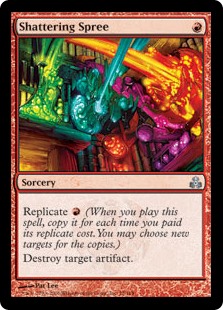 Therefore, just RRR will break you out of a Chalice on one and a Chalice on two. Be mindful that the original copy is countered by a Chalice on one, so you will generally have to replicate at least once. Other uses for Spree include blowing up the odd Cranial Plating or pesky Vault Skirge.
Therefore, just RRR will break you out of a Chalice on one and a Chalice on two. Be mindful that the original copy is countered by a Chalice on one, so you will generally have to replicate at least once. Other uses for Spree include blowing up the odd Cranial Plating or pesky Vault Skirge.
It's important with this deck not to over-sideboard. You need a very high density of cards to fuel your combo, so you can't start cutting them or you will end up with a non-functional deck. My first cuts are generally the filler cards: Remand, Thought Scour, and Merchant Scroll. Past that, you need a really good reason to bring in more cards. Affinity is the only deck where I could see wanting more, but honestly I'd probably leave the Lightning Bolts in the sideboard unless I saw multiple Ethersworn Canonist effects in the next game.
Amonkhet and Modern
As I'm writing this we don't have the full Amonkhet spoiler available yet. But there are definitely a few cards that stick out to me as being able to slot into some existing Modern decks. For each of these, I'll touch briefly on my impressions of its financial relevance.
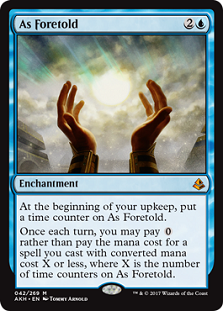 As Foretold: I'm sure you've read loads about how As Foretold lets you cast cards with no mana cost and suspend (Living End, Ancestral Vision, Restore Balance, etc.), but the financial impact on those cards has already been felt. I'd probably wait and see if anyone manages to find a good shell for this card but I think it's more likely to be used in control than combo. Being able to use the free spell on both players' turns can really help to turn the tide in a control deck's favor. I think this is a card to keep an eye on but not to go out and buy now.
As Foretold: I'm sure you've read loads about how As Foretold lets you cast cards with no mana cost and suspend (Living End, Ancestral Vision, Restore Balance, etc.), but the financial impact on those cards has already been felt. I'd probably wait and see if anyone manages to find a good shell for this card but I think it's more likely to be used in control than combo. Being able to use the free spell on both players' turns can really help to turn the tide in a control deck's favor. I think this is a card to keep an eye on but not to go out and buy now.
Gideon of the Trials: If your Ad Nauseam matchup is really bad I guess you could play this, but I don't see it becoming a Modern all-star. I know I have seen a lot of people talking about the emblem making a lot of decks have to jump through hoops to win, but you could just play Storm instead and ignore it. I would recommend staying away from Gideon right now—its price tag is much too high.
Harsh Mentor: Harsh Mentor has a lot of applications that could be great for aggressive red decks in Modern. I'm not sure if it's maindeck-worthy yet, but being able to tax your opponent's fetchlands at a minimum can help shape this card's future. 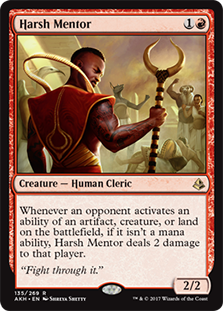 It's a particularly juicy card to play against Affinity because it triggers off Steel Overseer, Arcbound Ravager, Cranial Plating, and Inkmoth and Blinkmoth Nexus. It won't be as universally good as Eidolon of the Great Revel, but it will likely be an important sideboard card in the future.
It's a particularly juicy card to play against Affinity because it triggers off Steel Overseer, Arcbound Ravager, Cranial Plating, and Inkmoth and Blinkmoth Nexus. It won't be as universally good as Eidolon of the Great Revel, but it will likely be an important sideboard card in the future.
Vizier of the Menagerie: This guy will likely find a home in Elves and potentially other decks due to its stats and power. It's relevant that Vizier of the Menagerie dodges both Lightning Bolt and Abrupt Decay. He will probably replace Lead the Stampede in Elves decks and might find a calling in mono-green devotion-style strategies like Nykthos Green or Tooth and Nail. There may also be some weird combo involving Congregation at Dawn that lets you set up an infinite loop with Melira or the like.
Final Thoughts
I think Storm is in a great position right now, from both a financial and a gameplay standpoint. It's not overbearingly powerful where I would be worried about a ban, but it's also functional enough that you don't feel like you're not playing the same game. Hopefully this helps you out in the future and you enjoy saying "storm count" to your opponents.





Hi ! I’m not a Storm player but you can swap an Island for a Snow-Covered Island. There is no actual opportunity cost to my knowledgde as nobody cares about opponent snow permanents and some people run snow lands for no reason so you don’t give actual information.
It lets you build some different Gift piles if you need an island after Blood Moon…Island +Snow-Covered Island + Past in Flames + Manamorphose, for instance.
Not common but I guess it could matter once in a while.